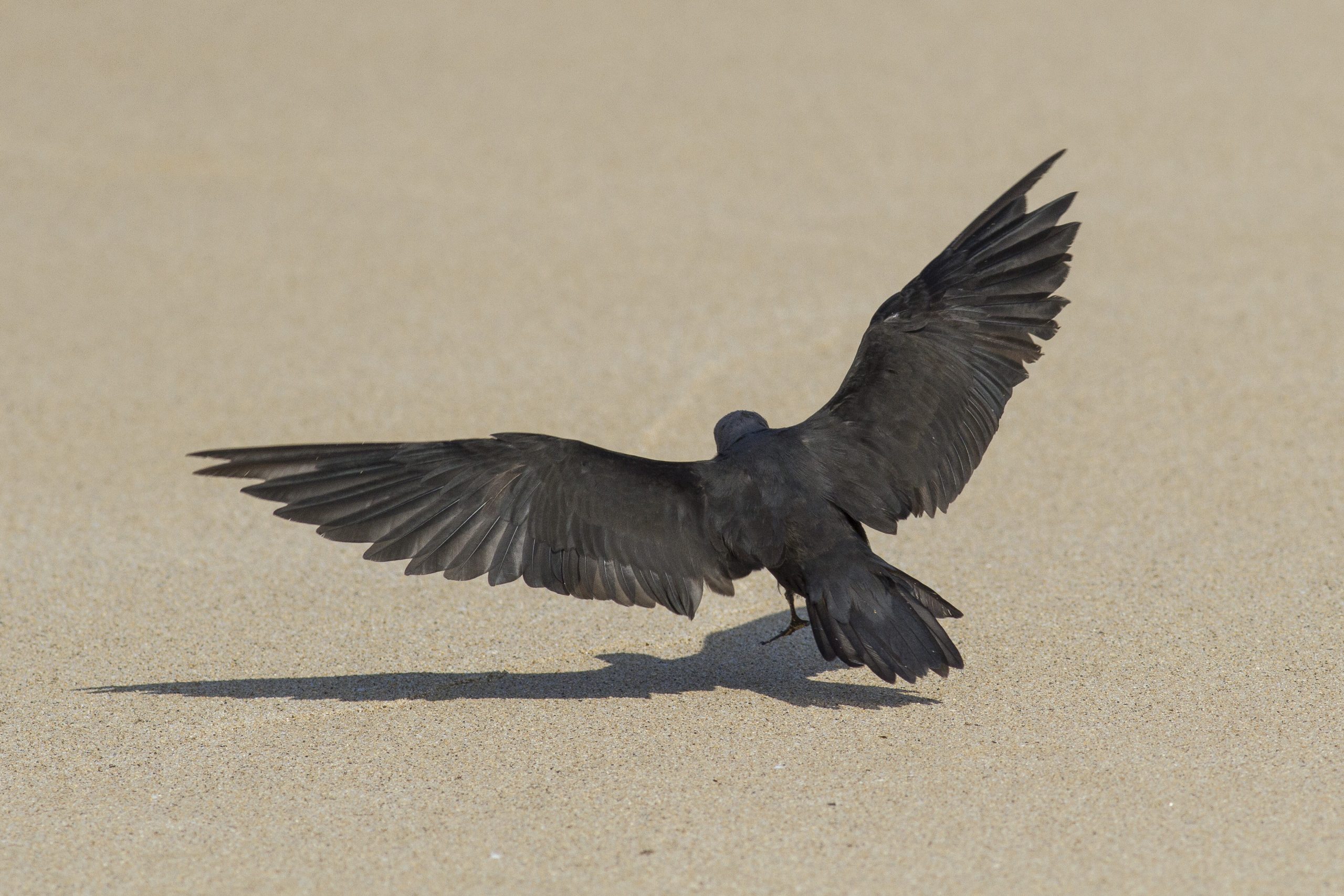Noio
Names
- ʻŌlelo Hawaiʻi: Noio
- Common: Black Noddy
- Scientific: Anous minutus
Song
Conservation Status
- State recognized as Indigenous
- NatureServe Heritage Rank G5 – Secure
- North American Waterbird Conservation Plan – Moderate concern
- Regional Seabird Conservation Plan – USFWS 2005
Species Information
The noio or black noddy is a medium-sized, abundant, and lives in flocks (Family: Laridae). It is distributed around the tropical regions of both hemispheres. Seven noio (black noddy) subspecies are generally recognized, and two are resident in Hawai‘i: A. s. melanogenys (MHI) and A. s. marcusi (NWHI). Individuals have slender wings, a wedge-shaped tail, and black bill which is slightly decurved. Adult males and females are sooty black with a white cap and have reddish brown legs and feet; bill droops slightly. Flight is swift with rapid wing beats and usually direct and low over the ocean; this species almost never soars high. Often forages in large, hunting parties made of several species associated with schools of large predatory fishes which drive prey species to the surface. Noio (black noddy) generally forage in nearshore waters and feeds mainly by dipping the surface from the wing or by making shallow dives. Opportunistic, in Hawai‘i, noio (black noddy) primarily takes juvenile goatfish, lizardfish, herring, flyingfish, and gobies. Nests in large, dense colonies that include non-breeding juvenile birds. Established pairs return to the same nest site year after year. Breeding is highly variable and egg laying occurs year-round. Both parents incubate single egg, and brood and feed chick. Birds first breed at two to three years of age, and the oldest known individual was 25 years old.
Distribution
Noio (black noddy) breed throughout the Hawaiian Archipelago, including all islands of NWHI and the coastal cliffs and offshore islets of MHI. Outside of Hawai‘i, noio (black noddy) breed on islands throughout the world’s tropical oceans. Noio (black noddy) typically remain near (within 80 kilometers [50 miles]) their breeding colonies year-round.
Habitat
Terrestrial: Noio (black noddy) breed on oceanic and offshore islands, both on low-lying coralline sand islands and high volcanic islands. In Hawai‘i, noio (black noddy) place their nests on ledges and in crevices of coastal cliffs, in sea caves, and in ironwood (Casuarina spp.) trees. Marine: Nearshore waters.
Threats
- Introduced predators. Like all seabirds, adults and nests are susceptible to predation by rats (Rattus spp.), and feral cats (Felis silvestris). All sites in NWHI are free of rats and cats, however the MHI support large populations of non-native mammalian predators.
- Native predators. ‘Iwa or great frigatebirds (Fregata minor), Laysan Finches (Telespiza cantans), and shorebirds will depredate eggs and chicks.
- Habitat degradation. Non-native vegetation such as golden crown-beard (Verbesina encelioides) can alter potential nesting habitat and the removal of non-native ironwood trees from Midway could result in a reduction in nest sites.
- Human disturbance. Kayak and zodiac tours of sea caves used for nest sites can result in adults flushing from nests, resulting in predation by native birds.
- Nearshore pollution. Because noio (black noddy) forage close to shore, oil spills and dumping of waste may be more important to this species than those that forage far offshore. Oiled individuals are regularly seen in the NHWI.
- Overfishing. Because noio (black noddy) rely on predatory fish to drive prey to the surface, overfishing may eventually affect Hawaiian populations.
Plans & Projects
- Kauaʻi Endangered Seabird Recovery Project (KESRP)
- Maui Nui Seabird Recovery Project (MNSRP)
- Lehua Island Ecosystem Restoration Project
Additional Resources
For more information and references visit the DLNR State Wildlife Action Plan factsheets. DOFAWʻs species pages and State Wildlife Action Plan fact sheets are provided for general information and are not meant to be a citable, original source of data. If you are a student, researcher, or writer looking for a citable source, please explore the references below or find other original data sources, rather than citing these webpages. The references below were provided by the authors of the State Wildlife Action Plan fact sheets at the time of drafting:
- Gauger VH. 1999. Black noddy (Anous minutus). In The Birds of North America, No. 412 (Poole A, Gill F, editors.). Philadelphia, (PA): The Academy of Natural Sciences; and Washington DC: The American Ornithologists’ Union.
- Kushlan JA, et al. 2002. Waterbird Conservation for the Americas: The North American waterbird conservation plan, Version 1 Waterbird Conservation for the Americas, Washington, DC. 78pp. Available at: www.waterbirdconservation.org.
- NatureServe. 2003. Downloadable animal data sets. NatureServe Central Databases. Available at: https://www.natureserve.org/getData/vertinvertdata.jsp (March 10, 2005).
- U.S. Fish and Wildlife Service. 2005. Regional seabird conservation plan, Pacific Region. U.S. Fish and Wildlife Service, Migratory Birds and Habitat Programs, Pacific Region. Portland, (OR): U.S. Fish and Wildlife Service.




